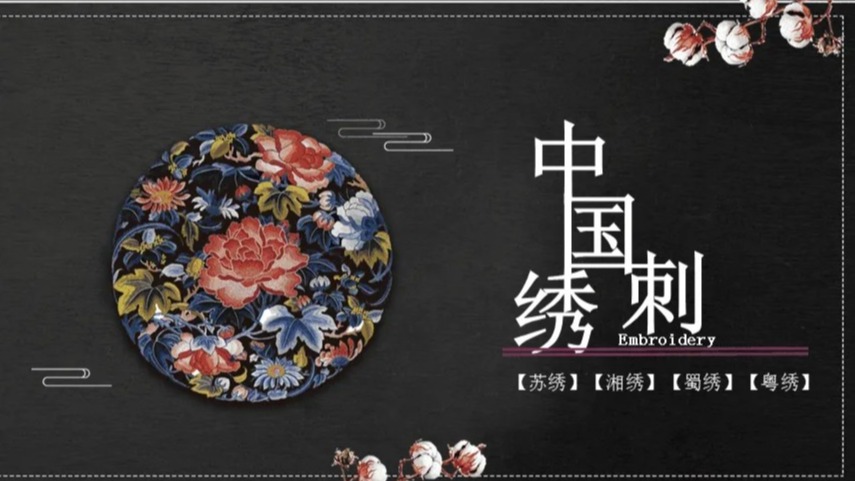Embroidery, also known as "needle embroidery", is commonly known as "embroidery". Embroidery is one of China's outstanding traditional ethnic crafts, in which a needle and colored threads are used to embroider patterns on silk or fabric in accordance with a designed pattern, forming a design or text. In ancient times, it was called "Zhen Zhi". Later, because embroidery was mostly done by women, it was also called "Nv Hong". Embroidery originated from people's need to decorate themselves. According to history, there were records of colorful patterns during the time of the Yellow Emperor. That is to say, the ancient primitive man knew how to use color to beautify themselves. In the beginning, colors were painted on the body; then further tattooed on the body, called "tattoo"; then painted on the clothes, and then developed into embroidery on the clothes.
Chinese embroidery, also known as silk embroidery and needle embroidery, is one of China's outstanding national traditional crafts. China is the earliest country in the world to discover and use silk, and people began to raise silkworms and reel silk four or five thousand years ago.
With the use of silk, the production and development of silk fabrics, the embroidery craft also gradually emerged, according to the Book of history, four thousand years ago, the chapter clothing system provides for "painting or embroidery on the clothes". During the Song Dynasty, the custom of embroidering clothes was gradually popularized among the people, which also promoted the development of Chinese silk embroidery. The four famous embroideries in China are Suzhou embroidery, Guangdong embroidery, Hunan embroidery and Sichuan embroidery.
Embroidery is a handicraft with a wide range of regions, and the embroideries of various countries and nationalities have their own characteristics and advantages through long-term accumulation and development. In China, besides the "four famous embroideries" of Suzhou embroidery, Hunan embroidery, Guangdong embroidery and Sichuan embroidery, there are also famous local embroideries such as Beijing embroidery, Shandong embroidery, Bian embroidery, Ou embroidery, Hangzhou embroidery, Han embroidery and Fujian embroidery, etc. The ethnic minorities in China such as Uygur, Yi, Dai, Buyei, Kazakstan, Yao, Miao, Tujia, Jingpo, Dong, Bai, Zhuang, Mongolia and Tibet have their own characteristics of ethnic embroidery.
By the Zhou Dynasty, there were records of embroidery official positions. The embroideries of the Warring States and the two Han dynasties unearthed in Hubei and Hunan are of high level. Tang and Song Dynasty embroidery has even and detailed needle eyes and rich colors, and it is popular to use embroidery for calligraphy, painting, ornaments and so on. During the Ming and Qing dynasties, the court embroidery of the feudal dynasties was very large in scale, and folk embroidery was also further developed, which successively produced Suzhou embroidery, Guangdong embroidery, Hunan embroidery and Sichuan embroidery, which were called the "Four Famous Embroideries". In addition, there are Gu embroidery, Beijing embroidery, Ou embroidery, Shandong embroidery, Fujian embroidery, Bian embroidery, Han embroidery and Miao embroidery, etc., which have their own styles and have been passed down till now. There are dozens of embroidery stitches, which are colorful and distinctive.
Embroidery is one of the most representative traditional handicrafts of the Chinese nation, which was born as early as the ancient times along with the ritual objects (bronze, jade), pottery and fabrics, and has been renewed from generation to generation. Nowadays, traditional handmade embroidery seems to be drifting away from us in the wave of industrialized production. However, "suddenly I turned, and there she stood, in the gloomy light", it turns out that embroidery is around people and not far away.
Formed in the mid-nineteenth century, the Four Famous Embroideries are the most classic of all embroideries. Besides its own artistic characteristics, another important reason for its emergence is the result of the commercialization of embroidery. Due to the different market demand and embroidery origin, embroidery crafts as a commodity began to form their own local characteristics, of which the products of Suzhou, Sichuan, Guangdong and Hunan are especially popular, so they are known as the "Four Famous Embroideries".
With the development and innovation of embroidery, many new embroideries have been formed today. In addition, there are many embroideries of border ethnic minorities, which also fully express the natural beauty and simplicity of the original style. The earliest embroidery was mostly for practical use, and then it became the production of calligraphy and painting in the Song and Yuan Dynasties, and then it was gradually used for art appreciation. Most of the embroideries in the collection of the Forbidden City belong to this category, which first appeared in the Five Dynasties period, and was used as supplies in the Qing Dynasty. Through the innovation and development of successive generations, embroidery has its own distinctive features and high achievements. The collection of the National Palace Museum in Taiwan is almost always a masterpiece, with even and neat embroidery, fine stitches, subtle colors, and the essence of calligraphy, and all framed into scrolls, so that the viewer is often mistaken for paintings and calligraphy, and its appreciation of the collection of artistic value is extremely high.
